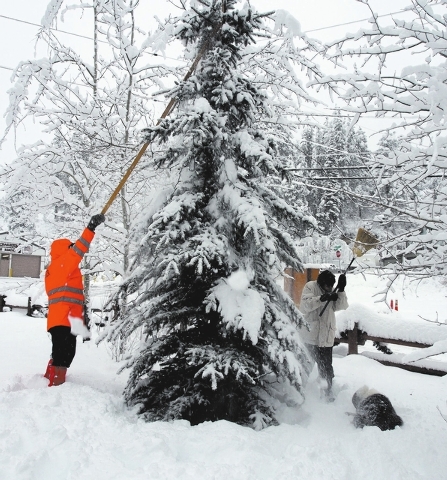Change coming for fire crews
The way fire and medical emergencies are handled at Mount Charleston is expected to change within two years.
Not for the big conflagrations like the Carpenter 1 Fire that blackened almost 28,000 acres of forestland in the Spring Mountains earlier this summer, and almost took homes in Kyle Canyon with it. U.S. Forest Service teams will continue to handle those. But for day-to-day fires, house fires, vehicle and sports accidents and medical assistance calls that every mountain community must deal with to prevent the big ones from happening in the first place and to save human lives and property.
The Mount Charleston Volunteer Fire Department, which has about 30 volunteers who donate their time to protect neighbors and mountain visitors, will continue to perform their good deeds. With support from the Clark County Fire Department, these unpaid firefighters are continually training to improve their medical emergency, wildland firefighting and skills.
But the Nevada Division of Forestry, which has been a key partner of the volunteers for decades, is due to reduce its public safety role in everything except forest fires by June 30, 2015. When that happens, it is expected to continue seasonal wildfire fighting efforts only from a separate facility at Lee Canyon.
In the meantime, the Clark County Commission has decisions ahead. Among its options:
■ Should the county’s volunteer fire station become a paid facility, making improvements needed so firefighters working 24-hour shifts there have living quarters?
■ Should the county use the Division of Forestry fire station for that purpose when the state leaves it, or use a combination of the state station and the county’s volunteer station?
■ Should the county hire the Division of Forestry firefighters who are based at the station?
“Nothing’s ruled out,” said Clark County Assistant Fire Chief Mike Johnson, who coordinates the department’s rural firefighting efforts.
Under the agreement, the state’s forestry agency will no longer provide “all-risk” emergency services on the mountain.
Those services include structure fires, vehicle accidents, medical calls, recreational accidents and search-and-rescue calls.
Those responsibilities will shift to the Clark County Fire Department, which has about 30 volunteer firefighters at Mount Charleston. Similar transitions are ahead for Elko and Eureka counties as part of the state’s transition.
State officials said the change will enable the Division of Forestry to devote its efforts to preventing and extinguishing wildfires. County and state officials had planned to meet and start talking about the transition shortly before the Carpenter 1 Fire scorched the mountain.
“Right now, we’re not sure exactly what the final product is going to be,” Johnson said.
For example, no decision has been made about where the manned station would be based. The county’s fire station for volunteers is one option. It could need some rehabbing. Its bay is too low for larger fire equipment, and it isn’t set up with living quarters for 24-hour shifts, Johnson said.
The Division of Forestry now uses a station in Kyle Canyon for the emergency calls. It’s possible that a combination of the two facilities — the county and state stations — could be the answer, Johnson said.
“We need to work through some of the things,” he said.
Whatever ends up happening, Johnson said, volunteers will continue to play an important role in responding to emergencies at Mount Charleston.
Scott Rasmussen, state fire management officer for the Division of Forestry, said the goal is for a seamless transition with no disruptions in the service residents receive.
“Both the county and the state are in a good working relationship to make this right,” he said.
Commissioner Larry Brown, whose district encompasses Mount Charleston, said any added costs of the county takeover, including putting a manned station in place, aren’t known yet.
“Fortunately, we have a solid year and a half to prepare for the transition,” Brown said.
County volunteer firefighters already have certifications to fight wildfires.
The county pays the Division of Forestry about $1.2 million a year for the staff and equipment to provide the emergency services. About $350,000 comes from the fire protection district’s property tax funds, $700,000 is from the county general fund, and consolidated taxes add about $130,000, according to the county’s figures.
The main Division of Forestry station in Kyle Canyon handles calls with six employees. A two-person crew is on duty at all times, with three rotating shifts.
Ryan Beaman, president of the Clark County Firefighters Local 1908, said the union will offer its input to the county after the planning is finished.
“We’ll work with the county to make certain the Mount Charleston facilities are capable of handling our equipment, and the residents and businesses have the coverage necessary; and we look forward to the county working with us to make sure our firefighters have the training and resources that severe wildfires require,” Beaman said.
Contact reporter Ben Botkin at bbotkin@reviewjournal.com or 702-405-9781. Follow him on Twitter @BenBotkin1.

















